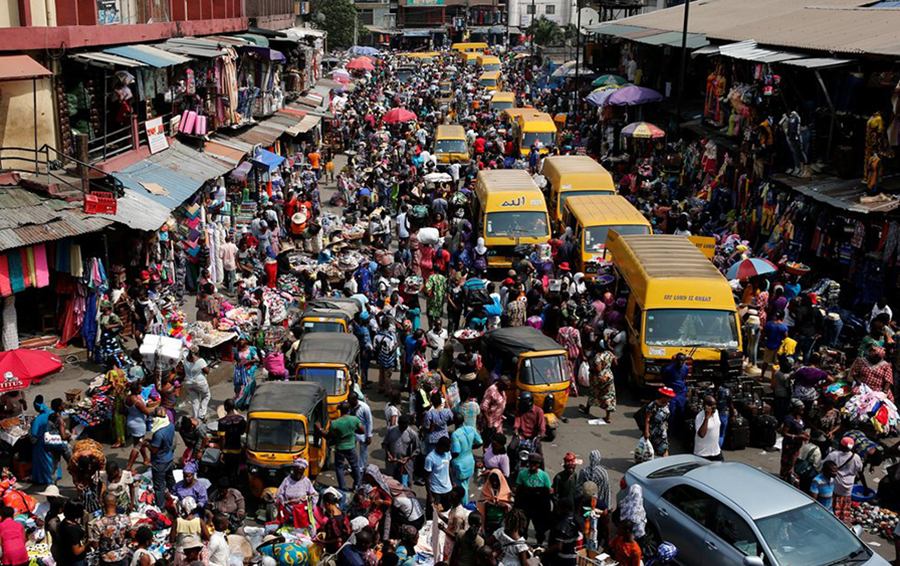Nigeria’s population has risen to 201 million in 2019. This was revealed in the latest State of World Population Report released by the United Nations Population Fund (UNFPA).
According to the UNFPA report, Nigeria’s population grew at an annual average growth rate of 2.6 percent in the last ten years. Between 1969 and 2019, Nigeria’s population grew by 267.4 percent. In 1969, Nigeria’s population was estimated at 54.7m people, while it has now increased to 201m in 2019.
Nigeria’s working population takes the highest share: According to UNFPA, Nigerians within the age group of 15-64years takes the highest proportion by age category, claiming about 54 percent of the total population. This age group represents Nigeria’s working population.
The country’s population is young: Also, the report further shows that Nigerians within the age group of 0-14 years rank second, comprising 32 percent of the country’s population, while Nigerians withing age group 10-24 years come third, constituting 32 percent of Nigeria’s population. Lastly, the least population of Nigerians fall within the age group of 65 above, comprising just 3% of Nigeria’s population.
What does this mean? This suggests that Nigeria has a very high prospect for economic growth, only if the country can harness its growth potentials in having the highest population in the working age category. It further stresses why unemployment is at such a high rate in the country.
Total fertility rate per woman declines: According to the World Health Organisation (WHO), total fertility rate is the average number of children a woman would have if she survives all her childbearing (or reproductive) years. Earlier in 2015, WHO stated that Africa remains the region with the highest fertility at 4.7 children per woman, while Europe has the lowest fertility of 1.6 children per woman.
According to the UNFPA data, the total fertility rate in Nigeria has been on the fall since 1969. Specifically, the total fertility rate per woman was 6.4, while it dropped to 6.3 in 1994 and currently declined to 5.3. This is still high when compared to Asia and Latin America and the Caribbean that reportedly have a total fertility of 2.2 children per woman.
Basically, whenever a country’s rate drops below approximately 2.1, then populations is expected to eventually start to shrink.

Life expectancy fared better but Nigeria ranks 178th: The UNFPA report shows that life expectancy in Nigeria fared better between 1969 and 2019. In 1969, total life expectancy was 41 years, while it currently stands at 55 years in 2019.
However, according to WHO data, Nigeria ranks 178th in the global world ranking of life expectancy, with male life expectancy being 54.7 years while the female stays at 55.7. Nigeria’s life expectancy is quite low when compared to the 80 years for developed countries.

[Also Read: Unemployment data reveals 20.9m Nigerians are unemployed]
Is Nigeria’s rising population a curse?: Nigeria’s estimated population of 201 million people comes at a time when the unemployment data is generating a lot of rows amongst policymakers and analysts alike.
According to the States’ Unemployment Data recently released by the National Bureau of Statistics, 20.9 million Nigerians were unemployed as at third quarter of 2018. The unemployment data further shows that the South Southern states of the country recorded the highest unemployment rates in the country, despite being some of the richest states in the country in terms of oil revenues and internally generated funds.
Rising population is not a curse in its sense, because it is still one of the biggest growth opportunities for any economy. Essentially, when fertility rates decline over a sustained period of time, the proportion of the working age population (i.e. over 15) grows relative to the economically dependent youth population.
This change in age composition creates a window of opportunity during which a country can potentially raise its level of savings and investment—a phenomenon now known as the ‘demographic dividend’.
Also, population growth increases density and, together with rural-urban drift, creates higher urban agglomeration. In essence, the large urban centers which allow for innovation and increased economies of scale lead to sustainable growth.
The downsides: However, rising population without a growing economy and development may have damning consequences on the economy. For instance, using the 2019 global population metrics as an example, Nigeria is ranked 158th globally in terms of GDP per capita of $2366. This does not look good for the economy, because GDP per capita is what measures the productivity of citizens per head.
Also, surging unemployment rates can equally lead to several social vices among the highest population age group in Nigeria, who have no jobs to earn means for livelihood. Hence, the multiplier effects of rising population amidst high unemployment in an economy cannot be overemphasised.





















sir, indeed, with this great critical breakdown and analysis of Nigerians population growth,you are an intelligent and brilliant man.